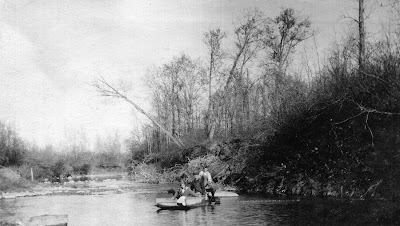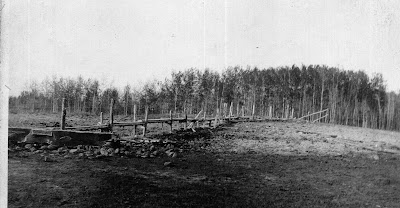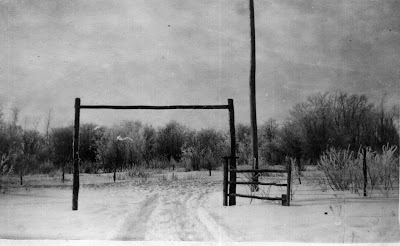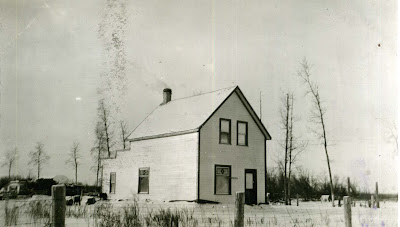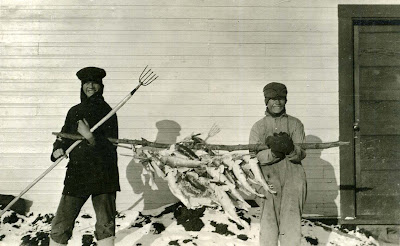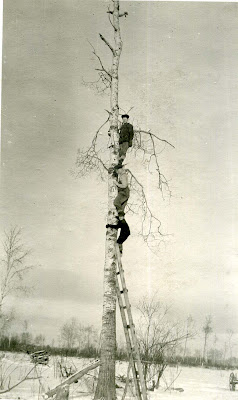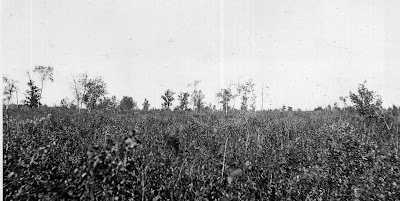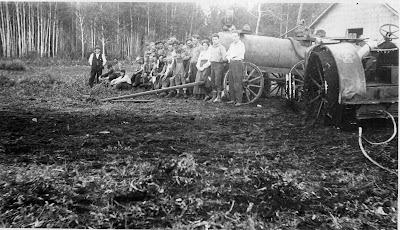A place is an ecology. Settling into an ecology means recognizing it accurately and then responding in a way that fits. So here we are: flat land, slow streams, low vegetation.

This stream is not identified and I've never seen a map of this farm's boundaries, so it's unclear to me whether this is the Favell River and whether it's the boundary. On flat land there's more of a tendency to survey everything into squares, but a stream is so real and strong that it can be almost irresistible as a boundary.

This photo might simply be a closeup of the previous snapshot. I see the same leaning tree on the right and pattern of stones on the left. If so, they are both the Roaring River, which is written under this photo. To a mountain person, it hardly appears to be "roaring" and the "rapids" look more like "riffles," or maybe just a good place to ford.

The caption says, "Our Hay Meadow was once a beaver pond." I would cap it the other way around: small letters for hay meadow and caps for "Beaver Pond," which is a such a significant engineering force in the West. Finding a riffle, they began to cut and drag the nearby trees, which were just the right size, into the fast water until they had plugged it up enough to create a dam with a pond behind it. (See earlier post about gradients!) The dam then gradually caught sediments that sank to the bottom of the pond until a good habitat for trout had become level muck that either required a higher dam or meant looking for a new riffle. This is true of all dams, even the mighty concrete man-made ones. Probably the beavers of this former dam were trapped and converted into gentlemen's hats long ago. We don't usually do that to the human builders of dams (no fur), but we do knock dams down eventually. All dams. By now the famous Aswan Dam in Egypt, a marvel of my youth, is filled up.
The muck behind the dams is fertile and till-able, wonderful natural meadow. The trees seem to have grown up together, the right hand set a little older (taller) and thicker than the left hand set which might have been thinned. Or maybe they somehow didn't get their share of water. Where are their lower limbs? There's foreground vegetation with the right hand row. Every ecology is a point in a process, a history, making a record of the past as well as controlling the future.
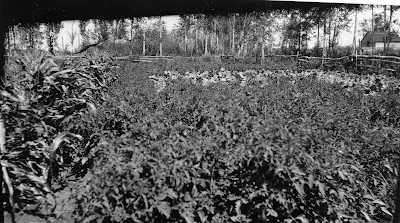
Corn, potatoes and cabbage -- right? High nutrition, store-able. Row crops. Annual. Sort of "low class" peasant food maybe, because people close to the soil survive on them.
This ecology reiterates everywhere: the same trees over and over, the same prairie perennials over and over, the same leaf pattern, over and over. So the potato plants and all the others over and over. If they weren't, it would signal a problem: pest, poison, lack of fertility, trampling.
So the people are capable of repetitious work, repeating schedules of planting, cultivation and harvest, eating the same foods again and again. Without flagging, without getting bored. Not unlike a computer data entry job. My grandmother coped by memorizing poetry she could repeat while hoeing. You can't do that when making computer data entries.

